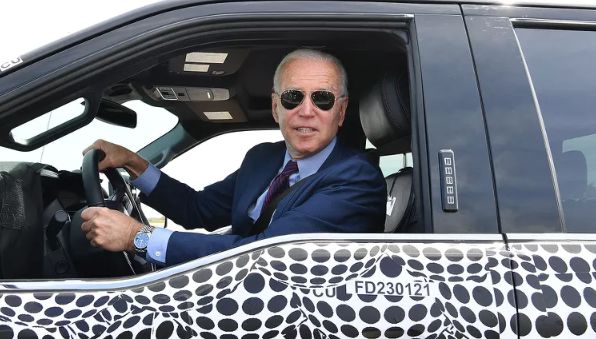Ford Motor Company is in the process of rethinking its production strategy for the all-electric F-150 Lightning pickup, a model once favored by President Joe Biden. This decision, which was revealed by Ford executives last Friday, proposes that approximately 1,400 employees at the Rouge Electric Vehicle Center in Dearborn, Michigan, be redeployed to different manufacturing roles within the firm or be given the option of early retirement packages.
The major manpower adjustment comes as a response to the reduced production of the all-electic F-150 Lightning, triggered by an apparent shortfall in demand from U.S. consumers. In recent discussions with suppliers, Ford executives provided insight into the company’s adjusted strategy, revealing their intentions to produce about 1,600 F-150 Lightnings per week at the Rouge facility. This represents a significant drop of 50 percent from their initial production target of 3,200 units per week.
Notably, President Biden had previously convened with Ford’s top brass in May 2021. The meeting aimed to highlight the F-150 Lightning in a bid to boost his administration’s green energy ambitions for the US economy. Yet, given the recent revelations from Ford, it seems that the embrace of electric vehicles (EVs) by consumers has not met the optimistic projections at that time.
In a move that might suggest the public’s preference, Ford’s management has also decided to hire about 900 auto workers in Michigan, predominately for the making of traditional fossil fuel-powered vehicles. This signals a strong demand from consumers for traditional vehicles, presenting a formidable challenge to the electric vehicle market.
The cutback on EV production by Ford presents another hurdle for the Biden administration’s efforts to integrate EVs into mainstream automotive consumption. This step towards green energy aims at encouraging American consumers and automotive manufacturers to accept this new technology as an integral part of their offering and lifestyle.
Yet, recent survey data from the Rasmussen Report presents an intriguing consumer sentiment. According to the survey, a sizeable 65 percent of American adults stated they were not inclined to consider an electric vehicle for their next automobile purchase. Within this group, 37 percent expressed they were ‘not at all likely’ to acquire an EV.
Interestingly, only less than three out of ten Americans conceded that they would consider owning an EV. This number is considerably lower than the anticipated uptake by the administration. The trend seems to suggest a resistance among consumers to shift away from traditional vehicle models.
A comprehensive Consumer Reports review undertaken towards the end of 2023 identifies EVs as having nearly 80 percent more issues than gasoline-powered automobiles featuring conventional combustion engines. This revelation may have further implications on the acceptance and adoption rates of EVs by the American consumers.
Significant challenges lie ahead to fulfill a green energy agenda with EVs at the center stage. Stumbling blocks, such as consumer perception and reality of EV performance, are affecting companies like Ford, resulting in a scale back on production.
In addition to this, the transition of employees from electric vehicle production to traditional vehicle manufacturing indicates a shifting trend. This shift may point towards market realities and customer preferences that contradict the expected embrace of electric vehicles.
The situation presents a conundrum for policy makers who aspire to a future dominated by electric vehicles. It’s a delicate balancing act between quickening the pace of technological adoption and being sensitive to market demands and public sentiment.
While it may seem like an uphill task at present, it’s crucial for stakeholders to continue dialogues and develop strategies that will resonate with the consumers. This means taking into account demographic factors, economic considerations, and technological capabilities, all while prioritizing the agenda for a clean energy future.
Manufacturers, in conjunction with policymakers, ought to consider innovative techniques to spark consumer interest in EVs. These could include awareness campaigns showcasing the benefits and feasibility of switching to EVs and incentives for prospective buyers.
The most effective strategy will probably be a combination of top-down policies encouraging EV adoption and grassroots effort in engaging the public in the necessity and benefits of transitioning to a clean energy future.
The challenges presented today may be transformed into possibilities with tactical planning, responsiveness to market dynamics, and sincere efforts to meet consumer needs and concerns. A future where EVs are the most common vehicle on the road may not be that far off.
As it stands currently, the journey to replace traditional gas-powered vehicles with electric ones is definitely fraught with obstacles. However, in the face of hard data and the reality lived by the auto companies like Ford, lies an opportunity to contemplate, learn, recalibrate, and move forward towards a more sustainable automotive future.
Read more on Real News Now


